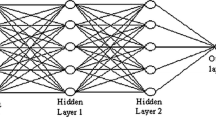Abstract
The current research attempts to offer a novel method for solving the Stokes problem based on the use of feed-forward neural networks. We transform the mixed Stokes problem into three independent Poisson problems which by solving them the solution of the Stokes problem is obtained. The results obtained by this method, has been compared with the existing numerical method and with the exact solution of the problem. It can be observed that the current new approximation has higher accuracy. The number of model parameters required is less than conventional methods. The proposed new method is illustrated by two examples.
Similar content being viewed by others
References
Nicolaides, R.A.: Analysis and convergence of the MAC scheme II, Navier–Stokes equations. SIAM J. Numer. Anal. 65(213), 29–44 (1992)
Girault, V., Raviart, P.A.: Finite Element Method for Navier–Stokes Equations: Theory and Algorithms. Springer, New York (1986)
Temam, R.: Navier–Stokes Equation, Theory and Numerical Analysis. North-Holland, Amsterdam (1984)
Thomasset, F.: Implementation of Finite Element Methods for Navier–Stokes Equations. Springer, Berlin (1981)
Eymard, R., Herbin, R.: A staggered finite volume scheme on general meshes for the Navier–Stokes equations in two space dimensions. Int. J. Finite Electron. 2(1) (2005)
Cockburn, B., Kanschat, G., Schötzau, D.: A locally conservative LDG method for the incompressible Navier-Stokes equations. Math. Comput. 74, 1067–1095 (2005)
Cockburn, B., Kanschat, G., Schötzau, D., Schwab, C.: Local discontinuous Galerkin methods for the Stokes system. SIAM J. Numer. Anal. 40, 319–343 (2002)
Girault, V., Rivière, B., Wheeler, M.F.: A discontinuous Galerkin method with noncon-forming domain decomposition for Stokes and Navier-Stokes problems. Math. Comput. 74, 53–84 (2004)
Ye, X.: Discontinuous stable elements for the incompressible flow. Adv. Comput. Math. 20, 333–345 (2004)
Griffiths, D.: Finite element for incompressible flow. Math. Methods Appl. Sci. 1, 16–31 (1979)
Ye, X., Hall, C.: A Discrete divergence free basis for finite element methods. Numer. Algorithms 16, 365–380 (1997)
Ye, X., Hall, C.: The Construction of null basis for a discrete divergence operator. J. Comput. Appl. Math. 58, 117–133 (1995)
Wang, J., Ye, X.: New finite element methods in computational fluid dynamics by H(div) elements. SIAM J. Numer. Anal. 45, 1269–1286 (2007)
Wang, J., Wang, X., Ye, X.: Finite element methods for the Navier-Stokes equations by H(div) elements. J. Comput. Math. 26, 410–436 (2008)
Hammerstrom, D.: Neural networks at work. IEEE Spectr. 26–53 (1993)
Debar, H., Becke, M., Siboni, D.: A neural network component for an intrusion detection system. In: Proceedings of the IEEE Computer Society Symposium on Research in Security and Privacy (1992)
Tan, K.: The application of neural networks to UNIX computer security. In: Proceedings of the IEEE International Conference on Neural Networks, vol. 1, pp. 476–481 (1995)
Helman, P., Liepins, G.: Statistical foundations of audit trail analysis for the detection of computer misuse. IEEE Trans. Softw. Eng. 19(9), 886–901 (1993)
Davidon, W.C.: Variable metric algorithm for minimization. Argonne National Laboratory Report ANL-5990 (Rev.) (1959)
Fletcher, R., Powell, M.J.D.: A rapidly convergent descent method for minimization. Comput. J. 6, 163–168 (1963)
Luenberger, D.G.: Linear and Nonlinear Programming, 2nd edn. Addison-Wesley, Reading (1984)
Aman, M., Kerayechian, A.: Solving the Stokes problem by linear programming methods. Int. Math. J. 5(1), 9–22 (2004)
Author information
Authors and Affiliations
Corresponding author
Rights and permissions
About this article
Cite this article
Baymani, M., Effati, S. & Kerayechian, A. A Feed-Forward Neural Network for Solving Stokes Problem. Acta Appl Math 116, 55 (2011). https://doi.org/10.1007/s10440-011-9627-5
Received:
Accepted:
Published:
DOI: https://doi.org/10.1007/s10440-011-9627-5




